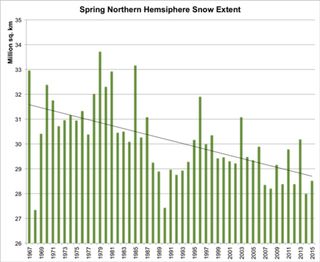Leonardo DiCaprio Is Kind of Right About Less Snow

Snow might not be as hard to come by as Leonardo DiCaprio suggested it was during his Oscar acceptance speech Sunday night (Feb. 28), but climate trends do suggest that the actor is onto something, experts said.
Moments after receiving the Oscar for best actor, DiCaprio reminded Hollywood, and the world, that "climate change is real" and that it affected the filming of his award-winning 2015 movie, "The Revenant."
"Making 'The Revenant' was about man's relationship to the natural world," DiCaprio said at the Dolby Theatre in Los Angeles. "A world that we collectively felt in 2015 as the hottest year in recorded history. Our production needed to move to the southern tip of this planet just to be able to find snow." [5 Places Already Feeling the Effects of Climate Change]
But is there really less snow than usual? The answer is yes, but only during the spring, said David Robinson, a professor in the Department of Geography at Rutgers University in New Jersey.
"I heard [DiCaprio's] speech and smiled," Robinson told Live Science. "He was of course a bit over the top with his statement. While snow cover has disappeared earlier in the spring in recent decades, there have been no major changes in winter snow [cover]."
Robinson tracks snow cover over the Northern Hemisphere using weekly and daily satellite data that goes back to 1967. (Snow cover shows surface area covered with snow and not the total amount, he noted.)
Take this chart, for instance, that Robinson and his colleagues created using such satellite data. It shows snow cover in the month of May from 1967 to 2015.
Sign up for the Live Science daily newsletter now
Get the world’s most fascinating discoveries delivered straight to your inbox.

The green bars show how much more or less million square kilometers of snow the Northern Hemisphere got compared with the average each year. In the 1970s and early 1980s, there was more snow cover than usual. But from the late 1980s onward, except for a few years here and there, there has been much less snow cover than usual, Robinson said.
This below-average cover isn't a blip either, "it's a statistically significant trend," he said.
Another chart shows how many million square kilometers of snow covered the Northern Hemisphere in the spring during the months of March, April and May, over the years. The diagonal linear regression line shows a clear trend — that the Northern Hemisphere is getting less snow cover in the spring over time.
In fact, Robinson and his colleagues noticed this trend and published a study on it in 1990 in the journal Geophysical Research Letters, noting that, "Northern Hemisphere snow cover during 1988 and 1989 was at its lowest extent since the advent of reliable satellite snow-cover monitoring in 1972; running some 8 to 10 percent below the 18-year annual mean of 25.7 million km squared [9.9 million miles squared]."

Robinson and his group also created a map showing where there was above- or below-average snow cover in May 2010, the lowest May snow cover on record — with brown and orange regions showing less snow than usual, white areas showing typical or no snow cover and the blue regions showing more than average snow cover.
Large swaths of Canada, Alaska and Russia are covered with brown and orange, meaning they got less-than-average snowfall during that time, Robinson said. [8 Ways Global Warming Is Already Changing the World]

"This kind of answers the question, 'Where should there have been snow that May?'" Robinson said. "Getting back to DiCaprio's remarks, this is where you would look in May to see where the snow is disappearing."
Big picture
The disappearing snow cover in spring has a number of concerning implications, Robinson said. Snow reflects the sun's rays. If there's no snow, that light gets absorbed into the ground, where it can melt the frozen soil, known as permafrost.
Warming and exposed permafrost can release methane, a powerful greenhouse gas, Robinson said. Furthermore, without snow reflecting the sun's energy in the Arctic, the atmosphere ends up absorbing some of that energy. This increases temperatures and may be linked to increased summer sea-ice melt, Robinson said.
"There's a lot of ramifications," Robinson said. "If we melt more permafrost because we lose the snow earlier, we put more methane into the atmosphere that further amplifies climate change."
He noted that the dataset does not include snow cover in the Southern Hemisphere, where parts of "The Revenant" were filmed, according to the Internet Movie Database.
It's unclear whether the actor is aware of Robinson's research, but both are working to learn more about Earth's climate.
"Let us not take this planet for granted," DiCaprio said during his speech. "I do not take tonight for granted. Thank you so very much."
Follow Laura Geggel on Twitter @LauraGeggel. Follow Live Science @livescience, Facebook & Google+. Original article on Live Science.

Laura is the archaeology and Life's Little Mysteries editor at Live Science. She also reports on general science, including paleontology. Her work has appeared in The New York Times, Scholastic, Popular Science and Spectrum, a site on autism research. She has won multiple awards from the Society of Professional Journalists and the Washington Newspaper Publishers Association for her reporting at a weekly newspaper near Seattle. Laura holds a bachelor's degree in English literature and psychology from Washington University in St. Louis and a master's degree in science writing from NYU.
